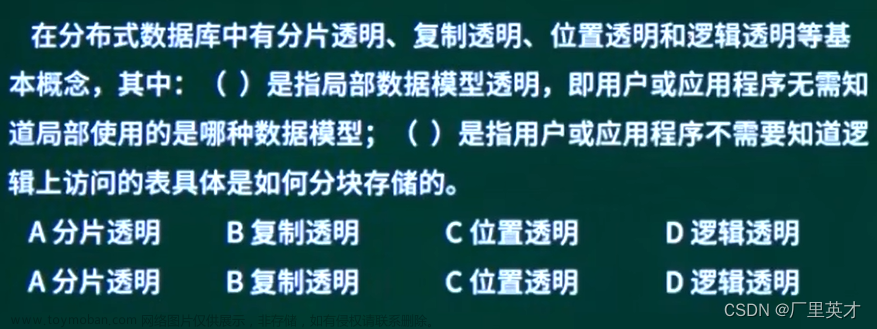目录
1、核心概念
消息和批次
Topic和Partition
Replicas
Offset
broker和集群
生产者和消费者
2、开发实战
2.1、消息发送
介绍
代码实现
2.2、消息消费
介绍
代码实现
2.3、SpringBoot Kafka
pom
application.yaml
KafkaConfig
producer
consumer
1、核心概念
消息和批次
kafka的基本数据单元,由字节数组组成。可以理解成数据库的一条数据。
批次就是一组消息,把同一个主题和分区的消息分批次写入kafka,可以减少网络开销,提高效率;批次越大,单位时间内处理的消息就越多,单个消息的传输时间就越长。
Topic和Partition
topic主题,kafka通过主题进行分类。主题可以理解成数据库的表或者文件系统里的文件夹。
partition分区可以理解成一个FIFO的消息队列。(同一个分区的消息保证顺序消费)
主题可以被分为若干分区,一个主题通过分区将消息存储在kafka集群中,提供横向扩展的能力。消息以追加的方式写入分区,每个分区保证先入先出的顺序读取。在需要严格保证消息顺序消费的场景下,可以将partition设置为1,即主题只有一个分区。
主题的分区策略有如下几种:
- 直接指定分区;
- 根据消息的key散列取模得出分区;
- 轮询指定分区。

Replicas
- 副本,每个分区都有多个副本。其中包含一个首领副本和多个跟随者副本。
- 首领副本用于响应生产者的消息写入请求与消费者的消息读取请求;
- 跟随者副本用于同步首领副本的数据,保持与首领副本一致的状态,有数据备份的功能。
- 一旦首领副本所在的服务器宕机,就会从跟随者中选出一个升级为首领副本。
Offset
偏移量。
生产者offset:每个分区都有一个offset,叫做生产者的offset,可以理解为当前这个分区队列的最大值,下一个消息来的时候,就会将消息写入到offset这个位置。
消费者offset:每个消费者消费分区中的消息时,会记录消费的位置(offset),下一次消费时就会从这个位置开始消费。
broker和集群

broker为一个独立的kafka服务器;一个kafka集群里有多个broker。
broker接收来自生产者的消息,为消息设置偏移量,并将消息保存到磁盘。同时,broker为消费者提供服务,对读取分区的请求做出响应,返回已经保存到磁盘上的消息。(单个broker可以轻松处理数千个分区以及每秒百万级的消息量)。
集群中同一个主题的同一个分区,会在多个broker上存在;其中一个broker上的分区被称为首领分区,用于与生产者和消费者交互,其余broker上的分区叫做副本分区,用于备份分区数据,防止broker宕机导致消息丢失。
每个集群都有一个broker是集群控制器,作用如下:
- 将分区分配给首领分区的broker;
- 监控broker,首领分区切换
生产者和消费者

生产者生产消息,消息被发布到一个特定的主题上。默认情况下,kafka会将消息均匀地分布到主题的所有分区上。分区策略有如下几种:
- 直接指定分区;
- 根据消息的key散列取模得出分区;
- 轮询指定分区。
消费者通过偏移量来区分已经读过的消息,从而消费消息。消费者是消费组的一部分,消费组可以保证每个分区只能被一个消费者使用,避免重复消费。
2、开发实战
2.1、消息发送
介绍
- 生产者主要有KafkaProducer和ProducerRecord两个对象:KafkaProducer用于发送消息,ProducerRecord用于封装kafka消息。
- 生产者生产消息后,需要broker的确认,可以选择同步或者异步确认:同步确认效率低;异步确认效率高,但需要设置回调对象。


代码实现
public static void main(String[] args) throws InterruptedException, ExecutionException, TimeoutException {
Map<String, Object> configs = new HashMap<>();
// 设置连接Kafka的初始连接⽤到的服务器地址
// 如果是集群,则可以通过此初始连接发现集群中的其他broker
configs.put("bootstrap.servers", "node1:9092");
// 设置key和value的序列化器
configs.put("key.serializer", "org.apache.kafka.common.serialization.IntegerSerializer");
configs.put("value.serializer", "org.apache.kafka.common.serialization.StringSerializer");
configs.put("acks", "1");
KafkaProducer<Integer, String> producer = new KafkaProducer<Integer, String>(configs);
// 用于封装Producer的消息
ProducerRecord<Integer, String> record = new ProducerRecord<Integer, String>(
"topic_1", // 主题名称
0, // 分区编号,现在只有⼀个分区,所以是0
0, // 数字作为key
"message 0" // 字符串作为value
);
// 发送消息,同步等待消息的确认
// producer.send(record).get(3_000, TimeUnit.MILLISECONDS);
// 使用回调异步等待消息的确认
producer.send(record, new Callback() {
@Override
public void onCompletion(RecordMetadata metadata, Exception exception) {
if (exception == null) {
System.out.println(
"主题:" + metadata.topic() + "\n"
+ "分区:" + metadata.partition() + "\n"
+ "偏移量:" + metadata.offset() + "\n"
+ "序列化的key字节:" + metadata.serializedKeySize() + "\n"
+ "序列化的value字节:" + metadata.serializedValueSize() + "\n"
+ "时间戳:" + metadata.timestamp()
);
} else {
System.out.println("有异常:" + exception.getMessage());
}
}
});
// 关闭连接
producer.close();
}2.2、消息消费
介绍
消费者主要有KafkaConsumer对象,用于消费消息。Kafka不支持消息的推送,我们可以通过消息拉取(poll)方式实现消息的消费。KafkaConsumer主要参数如下:

代码实现
public static void main(String[] args) {
Map<String, Object> configs = new HashMap<>();
// 指定bootstrap.servers属性作为初始化连接Kafka的服务器。
// 如果是集群,则会基于此初始化连接发现集群中的其他服务器。
configs.put("bootstrap.servers", "node1:9092");
// key和value的反序列化器
configs.put("key.deserializer", "org.apache.kafka.common.serialization.IntegerDeserializer");
configs.put("value.deserializer", "org.apache.kafka.common.serialization.StringDeserializer");
configs.put("group.id", "consumer.demo");
// 创建消费者对象
KafkaConsumer<Integer, String> consumer = new KafkaConsumer<Integer, String>(configs);
final Pattern pattern = Pattern.compile("topic_[0-9]");
// 消费者订阅主题或分区
// consumer.subscribe(pattern);
// consumer.subscribe(pattern, new ConsumerRebalanceListener() {
final List<String> topics = Arrays.asList("topic_1");
consumer.subscribe(topics, new ConsumerRebalanceListener() {
@Override
public void onPartitionsRevoked(Collection<TopicPartition> partitions) {
partitions.forEach(tp -> {
System.out.println("剥夺的分区:" + tp.partition());
});
}
@Override
public void onPartitionsAssigned(Collection<TopicPartition> partitions) {
partitions.forEach(tp -> {
System.out.println(tp.partition());
});
}
});
// 拉取订阅主题的消息
final ConsumerRecords<Integer, String> records = consumer.poll(3_000);
// 获取topic_1主题的消息
final Iterable<ConsumerRecord<Integer, String>> topic1Iterable = records.records("topic_1");
// 遍历topic_1主题的消息
topic1Iterable.forEach(record -> {
System.out.println("========================================");
System.out.println("消息头字段:" + Arrays.toString(record.headers().toArray()));
System.out.println("消息的key:" + record.key());
System.out.println("消息的值:" + record.value());
System.out.println("消息的主题:" + record.topic());
System.out.println("消息的分区号:" + record.partition());
System.out.println("消息的偏移量:" + record.offset());
});
// 关闭消费者
consumer.close();
}2.3、SpringBoot Kafka
pom
<dependencies>
<dependency>
<groupId>org.springframework.boot</groupId>
<artifactId>spring-boot-starter-web</artifactId>
</dependency>
<dependency>
<groupId>org.springframework.kafka</groupId>
<artifactId>spring-kafka</artifactId>
</dependency>
</dependencies>application.yaml
spring:
kafka:
bootstrap-servers: node1:9092 # 用于建立初始连接的broker地址
producer:
key-serializer: org.apache.kafka.common.serialization.IntegerSerializer
value-serializer: org.apache.kafka.common.serialization.StringSerializer
batch-size: 16384 # 默认的批处理记录数
buffer-memory: 33554432 # 32MB的总发送缓存
consumer:
key-deserializer: org.apache.kafka.common.serialization.IntegerDeserializer
value-deserializer: org.apache.kafka.common.serialization.StringDeserializer
group-id: spring-kafka-02-consumer # consumer的消费组id
enable-auto-commit: true # 是否自动提交消费者偏移量
auto-commit-interval: 100 # 每隔100ms向broker提交一次偏移量
auto-offset-reset: earliest # 如果该消费者的偏移量不存在,则自动设置为最早的偏移量KafkaConfig
@Configuration
public class KafkaConfig {
@Bean
public NewTopic topic1() {
return new NewTopic("ntp-01", 5, (short) 1);
}
@Bean
public NewTopic topic2() {
return new NewTopic("ntp-02", 3, (short) 1);
}
}producer
@RestController
public class KafkaSyncProducerController {
@Autowired
private KafkaTemplate template;
@RequestMapping("send/sync/{message}")
public String sendSync(@PathVariable String message) {
ListenableFuture future = template.send(new ProducerRecord<Integer, String>("topic-spring-02", 0, 1, message));
try {
// 同步等待broker的响应
Object o = future.get();
SendResult<Integer, String> result = (SendResult<Integer, String>) o;
System.out.println(result.getRecordMetadata().topic() + result.getRecordMetadata().partition() + result.getRecordMetadata().offset());
} catch (InterruptedException e) {
e.printStackTrace();
} catch (ExecutionException e) {
e.printStackTrace();
}
return "success";
}
}
@RestController
public class KafkaAsyncProducerController {
@Autowired
private KafkaTemplate<Integer, String> template;
@RequestMapping("send/async/{message}")
public String asyncSend(@PathVariable String message) {
ProducerRecord<Integer, String> record = new ProducerRecord<Integer, String>("topic-spring-02", 0, 3, message);
ListenableFuture<SendResult<Integer, String>> future = template.send(record);
// 添加回调,异步等待响应
future.addCallback(new ListenableFutureCallback<SendResult<Integer, String>>(){
@Override
public void onFailure(Throwable throwable) {
System.out.println("发送失败: " + throwable.getMessage());
}
@Override
public void onSuccess(SendResult<Integer, String> result) {
System.out.println("发送成功:" + result.getRecordMetadata().topic() + "\t" + result.getRecordMetadata().partition() + "\t" + result.getRecordMetadata().offset());
}
});
return "success";
}
}consumer
@Component
public class MyConsumer {
@KafkaListener(topics = "topic-spring-02")
public void onMessage(ConsumerRecord<Integer, String> record) {
Optional<ConsumerRecord<Integer, String>> optional = Optional.ofNullable(record);
if (optional.isPresent()) {
System.out.println(record.topic() + "\t" + record.partition() + "\t" + record.offset() + "\t" + record.key() + "\t" + record.value());
}
}
}以上内容为个人学习理解,如有问题,欢迎在评论区指出。文章来源:https://www.toymoban.com/news/detail-704385.html
部分内容截取自网络,如有侵权,联系作者删除。文章来源地址https://www.toymoban.com/news/detail-704385.html
到了这里,关于kafka学习-基本概念与简单实战的文章就介绍完了。如果您还想了解更多内容,请在右上角搜索TOY模板网以前的文章或继续浏览下面的相关文章,希望大家以后多多支持TOY模板网!













